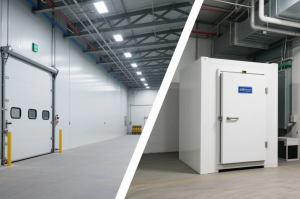1. Differences in refrigeration system configuration
Refrigeration unit selection
Large cold storage: usually uses screw or parallel piston compressor units to meet large cooling capacity requirements
Small cold storage: mostly uses a single piston or scroll compressor
Heat exchange equipment configuration
Condensation system:
Large cold storage prefers evaporative cooling or water cooling units, which have high heat dissipation efficiency
Small cold storage generally uses air-cooled condensers, which are easy to install
Evaporation system:
Both can use air coolers or exhaust pipes
Large cold storage uses steel exhaust pipes for more economical use
2. Equipment layout characteristics
Large cold storage requires an independent machine room to ensure equipment spacing and ventilation conditions
Small cold storage can flexibly use roof or side wall installation methods
3. Pipe system design
Pipe diameter selection:
Large Large cold storage needs to be equipped with large-diameter pipelines to reduce flow resistance
Small cold storage pipeline systems are relatively compact
Pipeline layout:
Large cold storage requires complex partitioned pipeline systems
Small cold storage pipeline layout is relatively simple
4. Electrical system configuration
Power supply system:
Large cold storage needs to be equipped with high-voltage three-phase power supply system
Small cold storage can use conventional low-voltage power supply
Control system:
Large cold storage uses PLC automation control system
Small cold storage is equipped with simple microcomputer controller
5. Project implementation characteristics
Construction complexity:
Large cold storage involves heavy equipment hoisting and complex pipeline construction
Small cold storage installation process is relatively simple
Construction period:
Large cold storage construction period usually takes several months
Small cold storage can be installed and debugged within a few weeks
Post time: Apr-23-2025








